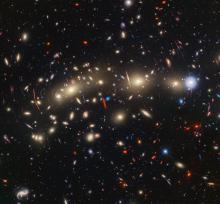Listen to today's episode of StarDate on the web the same day it airs in high-quality streaming audio without any extra ads or announcements. Choose a $8 one-month pass, or listen every day for a year for just $30.
You are here
A New Twist
Astronomers have discovered a new twist on an old galaxy. They’ve been studying M33, the Triangulum Galaxy, for more than 350 years. But a new study found that it’s not quite what it seems.
M33 is low in the west-northwest at nightfall, to the upper right of brilliant Venus, and is visible through binoculars. It’s more than two and a half million light-years away.
M33 has been considered a “flocculent” galaxy. That means it forms a disk with a lot of spiral arms and parts of arms. But when astronomers recently peered into the heart of M33 with Hubble Space Telescope, they found some surprises.
They plotted 22 million stars — old, young, and very young. And when they traced out those groups, they found three configurations.
The youngest stars, which tend to be brighter, formed the flocculent structure — spiral arms all over the place. The young stars mainly fell into two arms, connected by a bar of stars across the middle. And the older stars formed a flatter disk than the youngsters, with almost all of them in the two arms and the bar.
It’s impossible to tell what the galaxy looked like when it was born. It could have been hit or side-swiped by another galaxy fairly recently. That might have left the older stars in their original bar-and-two-arms arrangement. At the same time, it could have triggered the birth of new stars and created the many spiral arms we see today — a new twist to an old galaxy.
Script by Damond Benningfield






